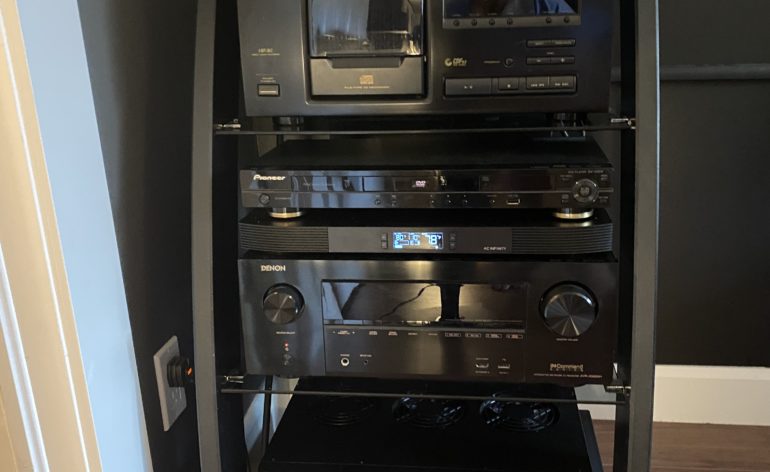Do I Need An External Amplifier?
I am a frequent visitor to several audio enthusiast websites and forums. One of the most frequent questions that I see is: Should I get an external amplifier for my set-up? Here is where you generally see two camps of thought. First is those who have external amplifiers and claim them make a world of difference. And then you have those who do not and claim they make zero difference. There is also a third camp, but we’ll get into that in a bit. But who is right? Let’s go over a few of the arguments I read most often and put a more critical lens to them. Oh, and to qualify my position. I have an external amplifier hooked up to my Denon X3600H, and I have used it with and without the amplifier.

Claim One – My Speakers Like Lots of Power
I hear this one a lot. I had a set of KEF LS50’s (87db sensitive), and I read the complaint that they didn’t get loud enough. They need, some claim, an external amp with lots of power to get the most from them.
So I hooked up my LS50’s (I sit 8′ away) to both my X3600 and then to my B&K external amplifier. We see 105wpc vs 185wpc in this comparison. I pulled out my trusty SPL meter, played the same song at 0db and saw…no difference.
Wait, Audessy is applying an EQ, and that’s the difference! That’s a fair statement. Audyssey keeps everything at predictable levels for consistent reproduction. So I turned it all off and saw…no difference.
So is this a valid claim? If you have standard speakers with average sensitivity and don’t sit at an insane distance, an external amplifier makes no difference and no sense for your set-up. IF you have esoteric, low-sensitivity speakers or your seating is very far from your speakers. Then an external amplifier makes sense for your set-up. If you are sitting far away and pushing your speakers hard, and you have a very low-powered amplifier, there is a chance you can clip your amp, so yes, in this case, “moar power is gooder!”
Claim Two – An External Amplifier Completely Changed the Sound of My Speakers
I am not wasting much time on this. An amplifier, whether it is internal or external, has precisely one job to do well. Amplify the signal from your source through your speakers. If an amplifier adds any coloration to the signal chain, it’s not doing its job correctly. The claims that an amplifier is warm, or bright, or bassy is little more than a psychological effect. There is no objective data that suggests anything else. If you add an external amplifier to your set-up and you “hear” a difference, it is confirmation bias – “I did a thing, so I hear a thing.”

Claim Three – My AVR Will Run Cooler With an External Amp
This is precisely the reason I bought my external amplifier. I honestly thought it would run much cooler if I took a load of my front soundstage off my Denon X3600H. It did not. And this is not subjective on my part. I have a pair of AC Infinity fans in my system, and they measure the heat coming off my gear. I found a marginal change of 2°C between running my speakers on the X3600 and the B&K external amplifier. The AV Infinity fans made my gear run cooler. The truth is that video processing is the leading cause of heat in AVR’s today. 4K adds a lot of demand on the processors in your AVR. This demand produces heat, as does amplification. But honestly, moving the front soundstage had almost no difference on my AVR’s heat output.

Claim Four – Separates Are Cheaper In The Long Run
This one is still really hard to defend. In the past, you bought a preamp/processor and an amp. Then, when you needed an update, you would buy only a new preamp/processor. The price difference between a very good integrated AVR and a PrePro was significant. Today, not so much.
The Denon X8500 is $4499 MSRP. It processes 13.2 channels and has 13 channels of amplification. The Marantz AV8805A retails for $4999 MSRP, processes 13.2 and has ZERO channels of amplification built-in. To add 13 channels of amplification will cost you $2499 MSRP for a seven-channel amplifier and an additional $1399 MSRP to get the extra five channels needed. So let’s do some quick math. Integrated costs $4499, and separates costs you $8897 and then $5k every time you upgrade your PrePro.
And yes, I know that the Monoprice HTP-1 is $4k and Emotiva has some $4k (or cheaper) options. But let’s be honest here, how often are you changing your receiver? I have a Denon X3600H, and it will be a VERY long time until I am willing to shell out for a new one. I would have to wait a lifetime to make my money back on shelling out for separates.

When Does An External Amp Make Sense?
As I stated above, there are some use cases for an external amplifier. If you have low-impedance, low-sensitivity speakers and genuinely need oodles of power, external amplification makes sense. Or, if you sit a considerable distance from your speakers and you need a lot of sound to fill your space, an amplifier and tower speakers make sense. Lastly, you want to have 7.2.4, and your amplifier does 11 channels of processing but only has nine channels built-in; an amp is your only option.
So, Smartguy, Why Did You Buy An External Amp?
I wanted it, and it was cheap. My B&K external amplifier was $2k in 1994, or $3700 today. I paid $150 at a pawn shop. Did I expect it to make a difference in my LS50’s? No! I admitted I did hope it would help with heat from my X3600H, but it didn’t. But, because I got such a great deal on it, I can sell it for more than I paid! Am I going to get rid of it? Nope! I like how it looks in my stack!
You Said Something About a Third Camp at the Beginning?
Yes, that’s me. I’m the guy that bought the amp and realized there wasn’t a difference. Most people don’t want to talk about that. If they mention it online, they get shouted down by those that either own an amp and believes that they make a huge difference, or those that don’t, but still believe they’d make a huge difference. This “silent” camp came to the realization that they “wasted” their money believing what people said on the Internet. I’m here to tell them that they didn’t. Sure, the external amplifier didn’t make the sonic difference you had hoped, but it looks cool! And isn’t that enough? Plus, if you ever upgrade to Atmos, you are going to need those extra amplifier channels.
Summary
External amplification has a minimal use case in most enthusiast set-ups. You will never hear any difference in your speakers for most, and if you do, I would be worried that the change is for the worse. Our suggestion? Spend the money for external amplification on something that would make a difference in your space, like a second subwoofer or room treatments. If you want one, and you have the free cash to do it, go ahead. Just understand, like in my set-up, it’s most likely cosmetic.



If an external amplifier is changing the sound of your music or movies through your speakers, then it’s acting as a tone control and not linear in power bandwidth and frequency response.
Back in the day, Hi-fi fans and home audio users had bass and treble control and some even equalizers in the system. Why? To tailor the sound to their hearing and tastes. And there was nothing wrong with that for audio is only important in how it sounds to you!
The vaunted audiophile and the cottage industry set up for the audiophile made an arbitrary decision to ban tone controls from their audiophile approved gear. They under the mistake that it was important to hear the music as it was recorded DID NOT NEED NO STUPID TONE CONTROLS! But they were wrong for your speakers, room and listening tastes may vary quite differently from the master recordings peddled to us all. After all do you really want Pete Townsend or Neil Young (both likely suffer major hearing loss over the years) mastering the music recordings for you?
In fact I believe AVR manufactures should bring back easy to adjust tone controls for even if you use room correction your tastes in sound may still vary from the room correction procedures. Bass, Mid and Treble nobs or sliders would be good things to put back on AVR’s
That’s a great point. My first Kenwood AVR and NAD 2 channel had tone controls. I absolutely had an EQ on my system. I loved the way it rose and fell, and I also loved to be able to play with it to tailor my system completely to my liking.
In my article, I was referring more to the Audiophile trend to suggest that a class of amplification could bring out warm tones, or some other subjective BS.
I agree with you, let’s bring back the tone control! And loudness!
Hey Andrew
I bought an Outlaw 5000 amp for my 5.1 setup because my bookshelf speakers are 4 Ohms nominal and my Marantz 6011 was running very warm. The fronts are 9 feet away, and the surrounds are 11 feet away due to our condo’s design. I don’t do any video processing through my receiver; it only performs Audyssey room correction for the audio.
Was there a difference in sound quality?
Yes, but it wasn’t night and day; the best way to describe the sound quality was it was more “coherent” than before. I’m not talking more detailed, but more “complete”…maybe more “cohesive”? If I had not bought the external amp, I wouldn’t have known the difference. Once again, the difference between the two experiences was slight, but noticeable. Thankfully, I only paid $600 for my B-stock amp.
The real difference was made when I switched the Marantz into Eco Mode. After doing so, the 6011 got to normal levels of warmth, but nothing near what it was without the external amp. As I live in a 1200 square foot, open floor plan condo, I don’t often “crank” it; when I played it at reasonable listening levels (30-40 decibels below reference), the receiver was still running really warm until I switched on Eco Mode.
I can’t remember whether or not your Denon has the ability to turn off the internal amp channels (my Marantz doesn’t), and I don’t know what your setup is, but putting your receiver into Eco Mode (if your setup allows) might alleviate some of the heat being generated by your receiver. As my Outlaw feeds all of the channels outside of the sub, I’m not using the internal amps of my Marantz.
And while you covered my scenario in your article, I thought this info might help other people with a similar situation. I know it did for me.
Thanks again for the nice article; more common sense and rational thought are greatly appreciated in an industry overrun by a lack of either.
Take it easy,
Jay
Hey Jay,
Thanks for the detailed reply.
I am glad you had a positive experience with your external amp, and $500 is a pretty decent price to pay to get one.
I never thought about activating eco mode on my Denon. I am going to give that a try this weekend and see if it impacts my system!
My whole bread and butter on AV is the common sense approach. I don’t claim to have Golden Ears, but I do know what I like and what I don’t like. Glad you are enjoying the content!
-A
This years denon models actually switchs off the internal amps when using external amps. Previous models do not hence why your denon still runs hot. H Comparing my old 120 watt per channel sony e.s to my denon 4400h 120 watts or hooking an external amp to the sony is like night and day.the sony is very bright and weak and was probably the worst avr i ever owned. Try comparing your amps while listening to music instead of movies less interference from correction software .